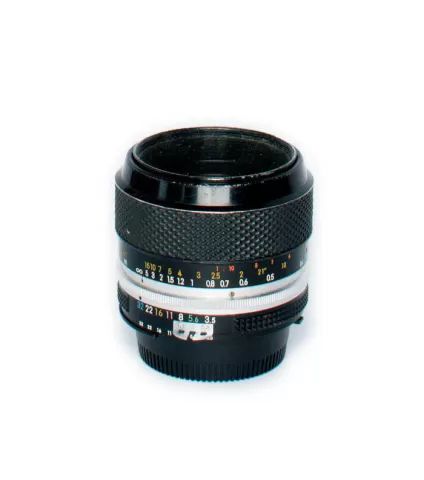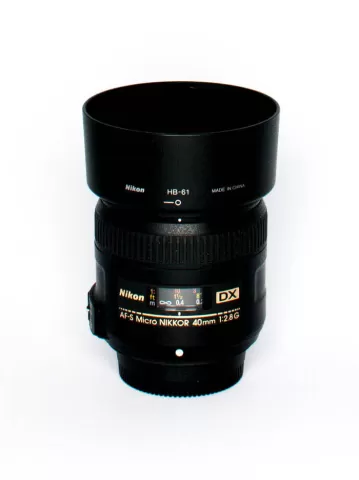I have Nikon DX bodies exclusively and shoot a lot of macro, so I bought both the 85mm f/3.5 and the 40mm f/2.8 DX Micro-Nikkors to supplement a couple of older macros I have.
Since this was written both my full frame camera arsenal and my macro arsenal has grown considerably.
I have owned a macro lens from about as early as I was able to afford one, which is all the way back to my Minolta and film era.
I simply love macros!
On SLR's macros do things that cannot be done without. While many compact cameras will shoot excellent close-up photos, the average zoom or prime lens for an SLR will not go close enough to do anything that can be called macro. And don't be fooled by the designation macro found on many general zoom lenses. They only rarely do macro as I would define it.
I simply love macros!
But the 85mm and the 40mm both do! They are in all ways full blown macros that have what typically characterizes macros: excellent optical quality, good build quality, a long focus range and with that the sometimes surprising change in size when you focus on close subjects.
Both lenses are AF-S in Nikon lingo, meaning that they have built-in focusing motors, again meaning that they will not only focus fast and quietly, but also work on all bodies, also those without a built-in motor and a so-called screw driver drive, namely the less expensive entry level bodies.
The 40mm f/2.8 is cheap (~185£) and a very fine lens, but not the ideal macro in my eyes due to the short focal length, which forces you to go very close if you want to shoot small things. If you can live with the short distance from the front of the lens to your subject, it's a great macro option.
The 85mm f/3.5 is an excellent lens, but slightly more expensive (~375£). It's a perfect macro focal length in my eyes, fast AF (and AF-S = AF on non-screwdriver bodies) and good manual focus as well as image stabilization. I bought mine used at about 60% of the list price, and it was mint. This is my go to macro lens.
Macro shots with my macro lenses shot at closest possible range and widest aperture. You can see that the 40 and 85mm lenses can go way closer than the old 55mm and the Sigma 90mm. The big difference between the Nikkor DX macros is the working distance. Below you see the setup with a D300s and the 40mm at the closest range, which is about 16 centimeters or 6 inches from the sensor plane to the subject. The closest working distance for the 85mm is almost twice that, but still gives the exact same magnification, which in both cases is 1:1.
I also have a Sigma 90mm f/2.8, which I bought it used years ago and still use. It has a aperture ring, which enables me to use it on a bellow (or with reverse rings, see below). It was 220 US$ - about 140£ - and great value for the price with slower AF and no focusing motor, but good manual focus (which I use most of the time anyway) and very fine image quality. Many similar non-Nikon 80-100mm macros are available at good prices, used as well as new. Most offer really good image quality.
A couple of years ago I was given an old Nikon 55mm f/2.8 manual focus macro. Yes, given! For free! I was thrilled because I had heard that these 60's and 70's macros were the best Nikon ever made. Well, either I got a bashed up copy or Nikon has made advances in building lenses since then (I tend to think the latter), because this lens has no chance against any of Nikon's current macros or the Sigma for that matter. It's a very nice lens, mechanically very smooth and nicely built, but in terms of sharpness and light control it's mediocre compared to current macros. I rarely use it.
I have shot with Nikon's 105mm f/2.8 macro on many occasions, and it is a really, really (like REALLY) nice lens, but also quite expensive. It's built to much higher specs than the two DX macros and will also cover a full frame sensor, and is much bigger and heavier than what I have. But it surely is a nice lens! On a full frame body this would be my first choice.
Why I like macros
I like macros because I shoot a lot of small stuff.
First and foremost I shoot fishing flies for my fly-fishing web site, books and magazine articles.
I also shoot in nature – flowers, fungi, insects, details.
Add to those that I sometimes shoot other details, like in fishing equipment, photo gear, computers and such.
All these require real macro, meaning a camera/lens combination that can depict subjects close to the same size on the sensor as they are in real life. In other words, a ½ inch or 1.5 centimeter thing will be projected onto the sensor in that size, meaning that when you see the image on a screen or in print, the item will fill most of the image frame.
One thing that you have to seriously consider if you shoot a lot of macro is using a compact Point & Shoot camera in stead. A modern P&S camera will mostly do very good macro, and if it has a 12 or 16 Mpixel sensor its pictures can easily be compared to what you can do with a cheap SLR and a macro lens in terms of getting close and sharp.
You get the image quality, which you can expect from a P&S. Some are excellent, some suck. I have good experiences with Canon's PowerShots and terrible experiences with Pentax and Fuji compacts. You also get JPEG and no RAW in 95% of the cases, but it still offers a very good and inexpensive alternative to a large macro setup.
Due to the small sensor and typically high apertures, compacts have a larger depth of field than most SLR/macro combos. This can be an advantage as well as the opposite, but for getting stuff sharp, it's actually hard to beat with any SLR.
Other alternatives
Reverse rings are cheap, but also pretty hard to use on modern lenses with no aperture ring. The lens is always stopped down to max aperture, which lets in very little light, and reverse rings typically go VERY close, especially on normal and wideangle lenses.
Extension rings are a good alternative, but the best ones are not cheap. I recommend a used dedicated macro in stead.
A really cheap alternative is magnifying lenses ("filters") that you screw onto the front of a lens. The quality can be surprisingly good and it's a very inexpensive way to get started.













